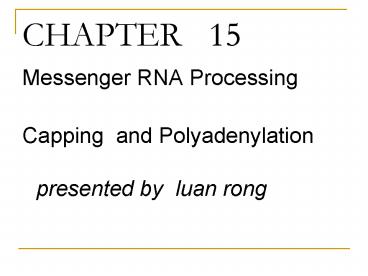Messenger RNA Processing - PowerPoint PPT Presentation
1 / 28
Title:
Messenger RNA Processing
Description:
Digest the labled capping substance(xp) to yield x by phosphomonoesterase,then ... II leave the complex; PAP enters .aided by CPSF initiates short poly(A) synesis. ... – PowerPoint PPT presentation
Number of Views:97
Avg rating:3.0/5.0
Title: Messenger RNA Processing
1
CHAPTER 15
- Messenger RNA Processing ?
- Capping and Polyadenylation
-
presented by luan rong
2
Part 1 capping
3
Reovirus cap structure
4
- Digest the labled capping substance(xp) to yield
x by phosphomonoesterase,then electrophoresis
this digest.then,paper chromatography.
5
Cap synthesis
- Sequence of events in capping?
- Verify the correct pathway
- Isolate each of the enzymes.
- ldentification of ppGpC as an intermediate in
reovirus cap sythesis.
6
(No Transcript)
7
5
-
caps and capping intermediates analysed
by paper electrophoresis with marks .one
radioactive intermediate coelectrophoresis with
the ppGpC to GpC.then alkaline phosphatase
convert ppGpC to GpC. - Ion-exchang chromatography to identify ppGpC.
8
Functions of caps
- Protection of the mrna from degradation(figure
15.6) - Enhancement of the mrna translatability.
- Tranport of mrna out of the nuleus.(figure 15.7)
- Proper splicing of the pre_mrna.
9
6
- Labeled revirus rnas with capped, bloked,uncapped
5end,subjected to glycerol gradient
ultercentrifugation. - Effect of incubation in xenopus oocytes and in
wheat germ extrat decapping ,debloking
10
Capping of u1 snrna is necessary for its
transport to the cytoplasm
11
Part2 polyadenylation
- Size of poly(A) (generally 200bp)
- Functions of poly(A).(figure 15.10-12)
- Basic mechanism of polyadenylation.(figure
15.14-26)
12
Effect of polyadenylation on translatability and
stability of mrna
13
Effect of polyadenylation on recruiment of mrna
to polysome
14
Basic mechnism of polyadenylation
- Two hypothesis of the polyadenylation process.
- Polyadenylation signals.
- Cleavege and polyadenylation of a
pre-mrna.(initiation-elongation)
15
Two hypothesis of the polyadenylation of
adenovirus major late transcripts
16
Importance of AAUAAA sequence to polyadenylation
- Mutant 1471 contains deplicated late
polyadenylation sites 240bp apart.deletion either
up/downstream site resulting in the loss of the
coresponding aauaa sequence in the pre-mrna
produced by mutant genes.
17
Effect of rna POL2A and 2O on prepolyadenylation
mrna cleavage in vitro
- Incubate labeled adenovirus l3 pre-mrna with
all the cleavage and polyadenyltion fators and
polymerase 2A/O no protein(_) or purified HeLa
cell SR protein.
18
Effect of the RpB1CDT on prepolyadenylation mrna
cleavage in vitro
19
A model for the precleavage complex
20
Two fractions are needed for polyadenylation
-
Separation of PAP and
specificity factor activity by DEAE-sepharose
chromotography(100/600mM) from hela cell.
Incubated them with ATP,then electrophoresed the
labeled rna and autoradiographed the gel.
21
Polyadenylation itsself consist of two phases
- Ues several different model RNA substrates
performed in hela nulear extract. - 1 58-nt substrate containing the 3-end of sv40
late mrna. - 2 the same rna with a 40-nt poly(A)
- 3 the same rna with A 40-nt 3-tag containing
vector sequence.
22
Demostration of two phases in polyadenylation
23
Thus ,by the time 40-As have been added
polyadenylation is independent of AAUAAA signals
- Hypothesisthe shortest poly(A) that could
override the effect of a mutation(AAUAAA)is 9 As
which sugesst that after cleavage of the
pre-mrna,polyadenylation depends on AAUAAA
signals and CPSF until the poly(A) reaches about
10 As in length. - If CPSF recognizes the polyadenylation signals
AAUAAA?
24
CPSF binds to the AAUAAA motif
25
Purification of poly(A) binding protein
26
Effect of CPSF and PABIIon polyadenlylation of
model substrate
27
Model for polyadenylation
- CPSF CstfF and CFI/II assemble on the pre-mrna
guided by AAUAAA and GU/U motifs.
cleavage occurs,stimulated by the CTP
OF RNPIICstF,CFI/II leave the complex
PAP enters .aided by CPSF
initiates short poly(A) synesis. - PABII enters the complex and allow the rapid
extention of the oligo(A) to a full-length
poly(A)
28
- THANK YOU































